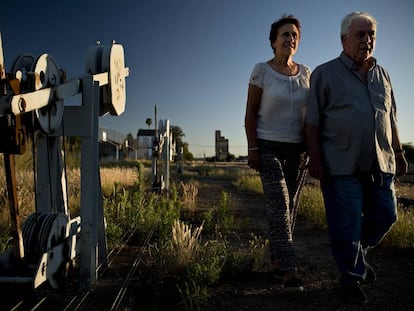US begins construction of high-speed train between Las Vegas and Southern California
The country’s first true bullet railway system is expected to be operational for the 2028 Summer Olympics and a round-trip ticket will cost around $400


A ceremony with confetti and smiling politicians has revived one of America’s old dreams: a high-speed rail line. Work began on Monday to connect Las Vegas (Nevada) with Rancho Cucamonga (California), about 40 miles east of Los Angeles. The 218-mile route is expected to be operational for the 2028 Summer Olympics, says Brightline Holdings, the company in charge of the $12 billion project. Half of this investment will be covered by the federal government, and the rest will be privately funded. Transportation Secretary Pete Buttigieg said the train will create “thousands of union jobs, new connections to better economic opportunities, less traffic and more clean air.”
The project aims to halve the four-hour trip across the Mojave Desert. The electric trains will serve some 11 million people, or about 30,000 passengers daily, according to forecasts shared by Brightline, which won the concession in 2019. The company estimates that about 50 million trips are made between Las Vegas and southern California annually. The vast majority, about 40 million, are made by land via the I-15 highway, which is congested in several parts of the Los Angeles metropolitan area.
Wes Edens, the president of Brightline, said in an interview with Los Angeles Times that the price of the ticket for a round trip will be approximately $400. The company already operates a similar line in Florida, where it connects the cities of Orlando and Miami in a trip that takes three and a half hours.
Officials in charge of the Brightline project traveled to the United Kingdom, France, Spain, and Japan to investigate the high-speed rail networks in those countries. The Florida train has a maximum speed of 125 mph, while the one that will connect Nevada and California will reach a top speed of around 200 mph, making it the only one in the entire country comparable to the Japanese bullet trains, the Tokaido Shinkansen.
This train is one of the key projects of President Joe Biden’s large infrastructure package, the Bipartisan Infrastructure Law. Last December, the federal government announced its commitment to inject oxygen into the U.S. railway network, which fell into decline after World War II, when Dwight Eisenhower presented several decrees to favor the auto and aeronautical industries.
Biden announced an investment of $8.2 billion in 10 passenger train lines. It is the largest expenditure since Amtrak, the country’s passenger railway company, was founded half a century ago. Of that pool of public resources, some $3 billion will be allocated to the Las Vegas-Rancho Cucamonga project. Brightline has also received federal approval to sell $3.5 billion in bonds that will be used for construction.
The Biden administration, which has increased its commitment to clean energy, said the train will help eliminate hundreds of thousands of trips between the two states, which translates into a reduction of 400,000 tons of polluting emissions. The government’s projections also envisage the creation of about 35,000 temporary jobs during construction and some 1,000 permanent jobs once operation begins.
Brightline’s goal is to link cities that are too close to fly between, but too far to drive. In Florida, the company reported losses of $190 million last year in the first nine months of operation (in which only the connection between Miami and Fort Lauderdale and Palm Beach worked).
Las Vegas needs more and better mobility options. The city’s population is approaching three million and it is consolidating its role as the largest tourist attraction in the west of the country. In addition to its casinos and hotels, the city is stealing the spotlight from parts of California with a new baseball team, a Formula 1 race and the potential arrival of an NBA franchise. Last year, its airport handled a record 57.6 million passengers. The last time Las Vegas saw a passenger train, the Desert Wind, enter its territory was in 1997.
Sign up for our weekly newsletter to get more English-language news coverage from EL PAÍS USA Edition









































